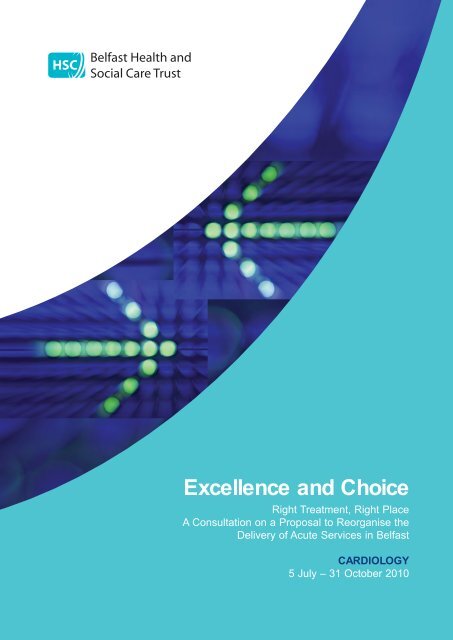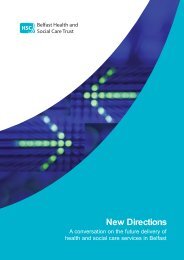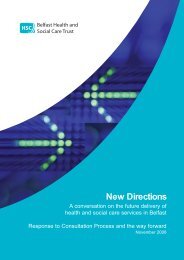Cardiology - Belfast Health and Social Care Trust
Cardiology - Belfast Health and Social Care Trust
Cardiology - Belfast Health and Social Care Trust
You also want an ePaper? Increase the reach of your titles
YUMPU automatically turns print PDFs into web optimized ePapers that Google loves.
We want to do all of this to ensure patients get the best treatment possible, by theright person, in the right place, at the right time. First, we want to listen to you. I hopeyou will take the time to read this document <strong>and</strong> let us know your views on theproposals. We remain committed to making improvements <strong>and</strong> delivering the type ofservice you expect. Help us to get it right.Patricia DonnellyPage 4 of 30
Service recommendationsIn summary, the Project Team recommendations were that:General cardiology services would continue to be provided at the <strong>Belfast</strong> CityHospital, Mater Hospital <strong>and</strong> Royal Hospitals.Tertiary <strong>Cardiology</strong> services should be located together at one hospital for thekey benefits of streamlined clinical pathways, team working, clinical rotamanagement <strong>and</strong> efficiency in service delivery.The Royal Hospitals offers the best location for the single, specialised cardiologyservice because:- The most important clinical linkages for cardiology services include cardiacsurgery <strong>and</strong> vascular services because patients with cardiovascular diseaseoften require treatment from a range of specialists. These specialists eitherwork together to treat complex problems or more commonly manage a patientwith a range of organs affected by cardiovascular disease. As part ofExcellence <strong>and</strong> Choice, it is proposed that vascular services would also bebased at the Royal Hospitals while cardiac surgery is already based at theRoyal Hospitals. Bringing together tertiary cardiology, cardiac surgery <strong>and</strong>vascular services provides an opportunity for physicians, surgeons <strong>and</strong>radiologists to provide optimal coordinated care for such patients in a„cardiovascular centre‟. Recent developments in less invasive techniques formanaging cardiovascular disease <strong>and</strong> the requirement for fast intervention incardiovascular emergencies further support bringing these services together.- Trauma services deal with multiple, serious injuries that could result in deathor serious disability. These might include serious head injuries, severegunshot wounds or road traffic accidents. Patients with multiple, seriousinjuries will need to be admitted to the Major Trauma Centre at the RoyalHospitals <strong>and</strong> may require rapid input from the tertiary cardiology team as partof a comprehensive trauma service.- There are four new Catheterisation Laboratories at the Royal Hospitals. Onelaboratory at the <strong>Belfast</strong> City Hospital needs to be replaced currently <strong>and</strong> theremaining two shortly thereafter. There is insufficient capacity to house sevenCatheterisation Laboratories at the <strong>Belfast</strong> City Hospital whereas there issufficient space in the Royal Hospitals.Page 6 of 30
Table 1 - Tertiary <strong>Cardiology</strong> Services - Current <strong>and</strong> Proposed ServiceLocations(s)<strong>Cardiology</strong> Services Current Location(s) ProposedLocation(s)Coronary <strong>and</strong> structural <strong>Belfast</strong> City Hospital/ Royal Hospitalsheart proceduresRoyal HospitalsCardiac Pacing <strong>and</strong> device <strong>Belfast</strong> City Hospital/ Royal Hospitalsimplantation procedures Royal HospitalsCardiac Electrophysiology <strong>Belfast</strong> City Hospital/ Royal HospitalsproceduresRoyal HospitalsGeneral cardiology wards& diagnostic services<strong>Belfast</strong> City Hospital/Mater Hospital/Royal Hospitals<strong>Belfast</strong> City Hospital/Mater Hospital/Royal HospitalsPage 7 of 30
1. Introduction – Right Treatment, Right PlaceThe creation of the <strong>Belfast</strong> <strong>Trust</strong> has provided us with the opportunity to review howwe can continue to improve quality, efficiency <strong>and</strong> sustainability of our acute servicesfor the longer-term.The <strong>Belfast</strong> <strong>Trust</strong>‟s overall purpose is to improve health <strong>and</strong> well-being <strong>and</strong> reducehealth inequalities – putting people at the centre of all decisions, providing serviceslocally where possible <strong>and</strong> making the best use of our buildings <strong>and</strong> other resources.We are also making sure there is no unnecessary duplication of services <strong>and</strong> ourmodernisation programme MORE 1 (Maximising Outcomes, Resources <strong>and</strong>Efficiencies) is helping us find the significant efficiency savings that the NorthernIrel<strong>and</strong> Assembly has asked all public bodies to make.This document describes the range of cardiology services we provide, how we areredesigning them <strong>and</strong> our commitment to ensuring they are of the highest possiblequality. We want to develop a single tertiary centre at the Royal Hospitals, bringingtogether the two separate teams to deliver a regional <strong>and</strong> local service providing thefull range of procedures in a modern environment. We are also streamlining ourpatient journey, ensuring that patients receive potentially life-saving interventionsfaster with improved outcomes.The <strong>Trust</strong>‟s proposed model is to combine the two separate catheterisationlaboratory units, currently there are three catheterisation laboratories at the <strong>Belfast</strong>City Hospital <strong>and</strong> four at the Royal Hospitals, eventually locating all sevencatheterisation laboratories <strong>and</strong> staff at the Royal Hospitals. This would form aspecialist centre for tertiary cardiology services.The <strong>Trust</strong> previously consulted, in New Directions, on the direction of travel for allservices delivered in <strong>Belfast</strong>. Ten overarching principles were developed to guideour approach to reviewing <strong>and</strong> reorganising services. Specific principles wereidentified for acute services, children‟s services, mental health <strong>and</strong> other services.Those principles of specific relevance to cardiology services are: To provide safe, high quality, effective care – This is a core objective of the<strong>Belfast</strong> <strong>Trust</strong>. Localise where possible, centralise where necessary – Services are moreeasily accessed by people when they are delivered locally, while specialistservices benefit from the concentration of expertise <strong>and</strong> experience requiredto deliver the highest possible levels of clinical care. The <strong>Trust</strong> therefore aimsto provide its services locally where the st<strong>and</strong>ard of service can be assured<strong>and</strong> centralise its services where it will raise the quality of provision.1 MORE: The co-ordination of strategic, clinical, operational <strong>and</strong> financial performance to deliver the best possible care forpatients <strong>and</strong> deliver maximum value for money.Page 8 of 30
Provide clear directions to services, developing clear pathways to accessappropriate care. To reduce unnecessary duplication <strong>and</strong> fragmentation of services. Maximise utilisation of assets – There is a clear need to make best use ofall existing health <strong>and</strong> social care infrastructure across the <strong>Trust</strong> <strong>and</strong> keep theneed for new buildings to a minimum while also addressing risk issues, suchas those attached to ageing buildings.In addition New Directions proposed that there would be differentiation of services toimprove patient care, based on the type of patient‟s condition <strong>and</strong> needs: <strong>Belfast</strong> City Hospital as the centre for cancer, renal <strong>and</strong> a range of generalacute hospital services, with an increased focus on elective services <strong>and</strong>chronic conditions management. The Royal Hospitals as the centre for major trauma services, including a heartcentre. The Mater Hospital as the centre for ophthalmology services <strong>and</strong> generalacute hospital services. Musgrave Park Hospital as the centre of specialist rehabilitation services.The <strong>Trust</strong> has produced this document to ensure that our staff, patients, carers <strong>and</strong>the public at large have an opportunity to provide their views on the new model fortertiary cardiology services.Page 9 of 30
activities in the heart. These are undertaken in very specialist facilities calledcatheterisation laboratories by specialist teams of staff. This is an examination roomwith diagnostic imaging equipment used to support the catheterisation process.Tertiary services delivered by the <strong>Trust</strong> include:- Percutaneous coronary intervention (PCI) or angioplasty;This is where a cardiologist uses a small inflatable balloon, often with a stent(cylinder of stainless steel mesh) mounted on it, to inflate a narrowed coronaryartery. The balloon compresses the blockage thereby allowing the blood to flow moreeasily. As the balloon is inflated, the stent exp<strong>and</strong>s so it holds open the narrowedblood vessel. The balloon is then deflated <strong>and</strong> removed, leaving the stent in placeIn addition, the <strong>Belfast</strong> <strong>Trust</strong> is also undertaking a pilot of providing Primary PCI topatients within the <strong>Belfast</strong> <strong>Trust</strong> catchment area on a 24 hours a day, seven days aweek basis. This is the gold st<strong>and</strong>ard to which all UK <strong>Trust</strong>s aim to reach for patientssuffering a ST Elevation Myocardial Infarction (STEMI heart attack). In this instancethe patient having a heart attack has, within a defined time period, a stent inserted toimprove blood flow rather than clot busting drugs.According to the National Infarct Angioplasty Project (NIAP) 2 , trials have shown thatPrimary PCI reduces the risk of death, further heart attack, stroke <strong>and</strong> the need forheart surgery compared to the use of clot busting drugs.This service is currently delivered from a catheterisation laboratory at the RoyalHospitals. Northern Irel<strong>and</strong> Ambulance Service have supported the <strong>Belfast</strong> <strong>Trust</strong> indelivering this pilot by immediately transporting patients with this suspecteddiagnosis to the Royal Hospitals.- Electrophysiology studies;Arrhythmia may take different forms <strong>and</strong> there are differing respective interventionsto diagnose <strong>and</strong> treat. Electrophysiology studies are a tool to diagnose problems ofthe conduction (electrical) system within the heart.- Ablation;Patients sometimes have a malfunctioning electrical circuit in the heart causingarrhythmias which is best treated by this circuit being shut down. Ablation is themethod for doing this using energy focused on the appropriate area of the heart toaddress this problem.2 British Cardiovascular Society & Department of <strong>Health</strong> (2008) Treatment of Heart Attack National Guidance, Final Report ofthe National Infarct Angioplasty Project (NIAP).Page 11 of 30
- Insertion of pacemakerPacemakers can be used in patients when the heart‟s own natural pacemaker is notfunctioning effectively. This may happen if the right <strong>and</strong> left side of the heart are notbeating together because the generation or conduction of electrical impulses is nothappening as normal.- Implantable cardiac defibrillator (ICD)An implantable cardiac defibrillator (ICD) can be inserted in a similar way to apacemaker if the heart rhythm is prone to developing a life threatening arrhythmia. Inthese instances, the ICD will deliver electrical pulses to correct the rhythm of theheart.This is what differentiates tertiary cardiology services from general cardiologyservices. A range of procedures are delivered as part of tertiary services, such as:Table 2 - Examples of General <strong>and</strong> Tertiary <strong>Cardiology</strong> Services<strong>Cardiology</strong> serviceExamples of servicesDiagnostic <strong>and</strong> interventional methods that do not requirethe use of cardiac catheterisation laboratories:GeneralcardiologyservicesTertiarycardiologyservices Inpatient cardiology services including Coronary <strong>Care</strong>Unit (CCU) Consultant-led outpatient clinics Nurse-led heart failure clinic Rapid Access Chest Pain Clinic Full range of non-invasive cardiac investigations Day case <strong>and</strong> in-patient TransesophagealEchocardiogram Exercise stress test Nurse-led cardiac rehabilitation <strong>and</strong> secondaryprevention service Emergency department support from a chest painnurse.Diagnostic <strong>and</strong> interventional procedures that do require theuse of a cardiac catheterisation laboratory such as: Percutaneous coronary intervention (PCI) Primary PCI Electrophysiology studies / Ablation Insertion of Pacemaker / ICDPage 12 of 30
Procedures undertaken in CatheterisationLaboratories 2009-2010Patients can access cardiology in one or more of the following ways: As an inpatient: an admission to hospital which includes an overnight stay As a day case: treatment which is carried out in a single day, without thepatient having to stay in hospital overnight As an outpatient: care provided on an appointment basis without requiringadmission to hospital. <strong>Cardiology</strong> outpatient services are not part of thisreview <strong>and</strong> will continue to be provided at the <strong>Belfast</strong> City, Mater <strong>and</strong> RoyalHospitals.<strong>Cardiology</strong> services can be delivered along one of two key patient pathways: Elective: This is when treatment has been planned <strong>and</strong> booked in advance,for example, a patient who is placed on a waiting list for pacemaker insertion<strong>and</strong> then brought into hospital on a prearranged day. Non-elective or emergency: This is when a patient accesses cardiologyservices without prior planning, for example a patient suffering a certain typeof heart attack who goes to one of the <strong>Trust</strong>‟s Emergency Departments (EDs)<strong>and</strong> is then brought to the catheterisation laboratory for treatment.Figure 1 illustrates the number of procedures that have been undertaken in 2009-2010 from the <strong>Belfast</strong> City Hospital <strong>and</strong> Royal Hospitals (RGH) catheterisationlaboratories as well as the <strong>Trust</strong>s combined figure.Figure 1 - Procedures undertaken in catheterisation laboratories by Hospital &<strong>Trust</strong> 2009-2010120001000080006000400020000BCH RGH BHSCTSeries1 3782 6069 9851Series2 38% 62% 100%Page 13 of 30
3. Why reorganise cardiology services now?The formation of the <strong>Belfast</strong> <strong>Health</strong> <strong>and</strong> <strong>Social</strong> <strong>Care</strong> <strong>Trust</strong> provides an opportunity tobuild on the current high quality tertiary cardiology services, ensuring that patientsare consistently treated by the right person, in the right place, at the right time.Specifically, the way specialties have developed in <strong>Belfast</strong> has resulted in afragmented system, with cardiologists that practise the same sub-specialty <strong>and</strong>delivering the same service not based on the same site. Tertiary services arecurrently safe <strong>and</strong> highly effective in both the <strong>Belfast</strong> City Hospital <strong>and</strong> the RoyalHospitals however there are reasons to change in order to further improveeffectiveness.Meet Public Expectation for Improved Service QualityIn line with the <strong>Trust</strong> principle to „localise where possible, centralise wherenecessary‟ the aim of tertiary cardiology services is to deliver safe, effective <strong>and</strong>sustainable services into the future. In order to ensure that the public expectation foraccess to modern, efficient services is achieved there needs to be ongoing review ofhow <strong>and</strong> where services are provided. The ability to provide an improved quality ofservice in tertiary cardiology services will be enhanced by providing services fromone location facilitating further development of sub-specialties.Drive Forward Service ModernisationAs treatment techniques <strong>and</strong> skills are developed there will be an increase in thenumber of patients treated as day cases <strong>and</strong> as outpatients. In addition, theincreased use of pre-assessment clinics, admission on the day of procedurecombined with reduced lengths of stay will result in a decrease in dem<strong>and</strong> forinpatient facilities. The tertiary cardiology service is embracing these changes, forexample, taking actions to deliver increased days cases in Percutaneous CoronaryIntervention. Locating these services together better facilitates best practice <strong>and</strong>modernisation throughout the clinical team.The Priorities for Action (PfA) 2010/11 document sets out the key priorities for <strong>Health</strong><strong>and</strong> <strong>Social</strong> <strong>Care</strong> services as identified by the Minister for <strong>Health</strong> <strong>and</strong> <strong>Social</strong> Services<strong>and</strong> Public Safety. It states:“In meeting all challenges faced by the service, the primary issue is how health <strong>and</strong>social care services are best configured to respond safely <strong>and</strong> effectively to theemerging needs of the individuals <strong>and</strong> populations they serve. As those needs <strong>and</strong>the technology to meet those needs develop, it may be right to provide someservices on single sites. Whilst other services may continue to be provided at localhospitals, the goal must be to ensure that the services provided are safe <strong>and</strong> of ahigh quality, delivering effective outcomes for patients.”Page 14 of 30
Address Current Duplication <strong>and</strong> Service EfficiencyTertiary cardiology services are currently duplicated, having developed across twohospitals within <strong>Belfast</strong>. Locating tertiary cardiology services together will enable thespecialty to maximise outcomes <strong>and</strong> resources <strong>and</strong> reduce any inefficiencies asthere will be reduced duplication of services, equipment <strong>and</strong> overhead costs.Act on Staff SupportClinical teams across the range of split-site specialties believe that there arepotentially significant benefits in bringing specialties together in the same hospital toform dedicated specialist units, for example, ensuring the development of subspecialistservices, flexibility in developing staff rotas, easier access to specialistnursing <strong>and</strong> other limited resources, improving team working <strong>and</strong> quality of service tothe patient.Improved Clinical LinkagesPatients who access tertiary cardiology services may need to interface with otherservices, such as:Vascular surgery <strong>and</strong> Cardiac surgeryPatients with cardiovascular disease often require treatment from a range ofspecialists. These specialists either work together to treat complex problems or morecommonly manage a patient with a range of organs affected by cardiovasculardisease. As part of Excellence <strong>and</strong> Choice, it is proposed that vascular serviceswould also be based at the Royal Hospitals while cardiac surgery is already based atthe Royal Hospitals. This creates the potential for a „cardiovascular centre‟ at theRoyal Hospitals <strong>and</strong> provides the best possible service for patients whether theirprimary condition is cardiac or vascular in nature as clinicians are in close proximityto plan patient‟s care in a holistic nature.Radiology servicesPatients of the tertiary cardiology service require radiology services as part of theirdiagnosis <strong>and</strong> treatment. Both the <strong>Belfast</strong> City Hospital <strong>and</strong> Royal Hospitals deliverthese radiology services <strong>and</strong> will continue to provide a service to patients from bothhospitals by making best use of the equipment <strong>and</strong> expertise of each hospital.Page 15 of 30
Trauma servicesTrauma services deal with multiple, serious injuries that could result in death orserious disability. These might include serious head injuries, severe gunshot woundsor road traffic accidents. Patients with multiple, serious injuries will need to beadmitted to the Major Trauma Centre at the Royal Hospitals <strong>and</strong> may require rapidinput from the tertiary cardiology team as part of a comprehensive trauma service.The key benefit of this is the potential to improve the knowledge base <strong>and</strong> stafftraining opportunities, resulting in better care for patients.Delivery on the Working Time Directive (WTD)Tertiary cardiology services have a significant challenge in complying with the WTDbecause of the unpredictability of on-call duties for staff delivering interventions forout-of-hours emergencies. This is because there is also a requirement to provide arange of tertiary cardiology services including elective (planned) diagnostic <strong>and</strong>interventional procedures the following day.The service requires a specialist multi-disciplinary team to deliver these diagnostic<strong>and</strong> interventional procedures in normal working hours <strong>and</strong> out of hours (foremergencies). Some of the various disciplines that form the multi-disciplinary teamhave small numbers of total staff. Therefore, bringing together all elements of thismulti-disciplinary team at a single hospital facilitates staff having appropriate resttime <strong>and</strong> prevents cancellation of elective (planned) patient‟s procedures.Consultant contract <strong>and</strong> service deliveryThe proposed amalgamation of tertiary cardiology services at one hospital haspositive implications for the use of the consultant workforce to deliver a morecoherent service <strong>and</strong> also gives the service the opportunity to modernise togetherrather than trying to develop tertiary services across two hospitals. Thedevelopment of one coherent service will also provide opportunities for sharedlearning <strong>and</strong> peer support for both junior doctors <strong>and</strong> consultants.Page 16 of 30
What are the main benefits of reorganising tertiary cardiology services now?Having identified the key reasons to review tertiary cardiology services, there are anumber of benefits for patients, staff <strong>and</strong> the hospitals which must be delivered inany proposed change on delivery or location of service. These were summarised intofive key areas, which guided the work of the project team in their review. They are:The delivery of safe <strong>and</strong> sustainable services to our patients:Providing safe services <strong>and</strong> ensuring patients are not at risk in our hospitals isour top priority. Having appropriately trained staff working in appropriatelysized teams will assist in both improving patient safety <strong>and</strong> sustaining theprovision of these services.To improve service quality, effectiveness, reduce unnecessary duplication <strong>and</strong>fragmentation of services <strong>and</strong> deliver value for money:Maintaining <strong>and</strong> improving the quality of care experienced by patients isfundamental to any proposal. Reducing the existing duplication of servicesacross two acute hospitals will mean patients see the right staff in the rightplace <strong>and</strong> this will also help teams deliver a more effective <strong>and</strong> efficientservice.The <strong>Trust</strong> must optimise the use of the current catheterisation laboratory stock<strong>and</strong> the support accommodation available to us <strong>and</strong> ensure that there is someroom for future growth, should the funding be available.To ensure services are appropriately clinically linked:Delivering services at the right time <strong>and</strong> in the right place requires certainservices to be located close to one another; for example, cardiology patientswill potentially need the skills of the vascular or cardiac surgery teams.<strong>Cardiology</strong> services are also required to support trauma services.To ensure services are accessible to patients <strong>and</strong> carers.Patients, carers, families <strong>and</strong> visitors want to have easy access to theirservices, whether by public transport or by car.To ensure the Acute Service Plan is compatible with the <strong>Trust</strong> Strategic DirectionThe <strong>Trust</strong> Strategic Direction, which has been previously publicly consulted upon, forthe four adult hospitals is:<strong>Belfast</strong> City Hospital as the centre for cancer, renal <strong>and</strong> a range of generalacute hospital services, with an increased focus on elective services <strong>and</strong>chronic conditions management.Page 17 of 30
Royal Hospitals as the centre for major trauma services, including a heartcentre, with an increased focus on emergency services;Mater Hospital as the centre for ophthalmology services <strong>and</strong> general acutehospital services;Musgrave Park Hospital as the centre of specialist rehabilitation services.The service project teams used these benefits criteria to assess how each serviceoption would deliver improvements for patients <strong>and</strong> staff <strong>and</strong> considered their impacton each hospital.Page 18 of 30
4. Consideration of the options for the future delivery of cardiology servicesA multi-disciplinary project team was established which brought together a broadrange of clinical <strong>and</strong> managerial staff from across the <strong>Trust</strong> including ConsultantCardiologists, imaging staff, nursing staff, AHP staff as well as patient <strong>and</strong> TradeUnion representatives, to generate <strong>and</strong> consider possible options for the futuredelivery of the service.The range of options considered by the Project team were:Option 1Option 2Option 3Option 4Continue with current arrangement – all emergency <strong>and</strong> elective(planned) tertiary services at both the <strong>Belfast</strong> City Hospital <strong>and</strong> RoyalHospitals.Deliver all emergency <strong>and</strong> elective (planned) tertiary services at the<strong>Belfast</strong> City Hospital.Deliver all emergency <strong>and</strong> elective (planned) tertiary services at theRoyal Hospitals.Deliver all elective (planned) tertiary services at the <strong>Belfast</strong> CityHospital <strong>and</strong> all emergency tertiary services at the Royal Hospitals.There is no change of service provision proposed at the Mater Hospital. Thereforeeach option accounts for the <strong>Belfast</strong> City Hospital <strong>and</strong> the Royal Hospitals only.Providing safe <strong>and</strong> sustainable servicesBringing together all tertiary services at a single hospital would better facilitate thedelivery of the Primary Percutaneous Coronary Intervention service because thesingle specialist team will be specifically focussed on best practice delivery of theseprocedures.In addition, bringing together all elements of the multi-disciplinary team required todeliver tertiary cardiology services at a single hospital increases the pool of staffavailable to cover emergencies at all times, facilitates staff having appropriate resttime in accordance with the WTD, <strong>and</strong> reduces the possible need for cancellation ofelective (planned) patient procedures.The single delivery teams in options two <strong>and</strong> three offer these potential advantagesbut the dual site options one <strong>and</strong> four do not.Improving service quality, reduce fragmentation <strong>and</strong> deliver value for moneySingle site working would deliver service efficiencies such as a streamlined clinicalpathway <strong>and</strong> improved clinical rota management by reducing the duplication ofproviding the same service on adjacent sites. The single site team would more easilymaintain best practice through increased sharing of expertise <strong>and</strong> learning facilitatedby clinicians working together in one unit. The overall volume of activity at the <strong>Trust</strong>Page 19 of 30
will not increase but this total volume through a single hospital, rather than splitacross multiple hospitals, can improve quality of care.Again, the single delivery teams in options two <strong>and</strong> three offer these potentialadvantages.Appropriate clinical linksPatients with cardiovascular disease often require treatment from a range ofspecialists. These specialists either work together to treat complex problems or morecommonly manage a patient with a range of organs affected by cardiovasculardisease. As part of Excellence <strong>and</strong> Choice, it is proposed that vascular serviceswould also be based at the Royal Hospitals while cardiac surgery is already based atthe Royal Hospitals. Bringing together tertiary cardiology, cardiac surgery <strong>and</strong>vascular services provides an opportunity for physicians, surgeons <strong>and</strong> radiologiststo provide optimal coordinated care for such patients in a „cardiovascular centre‟.Recent developments in less invasive techniques for managing cardiovasculardisease <strong>and</strong> the requirement for fast intervention in cardiovascular emergenciesfurther support bringing these services together.In addition, the Royal Hospitals is identified as the <strong>Trust</strong>‟s major trauma centre <strong>and</strong>tertiary cardiology services form part of the range of services that are required todeliver a comprehensive trauma service.Option three is the only option that can fully realise the development of acardiovascular centre.Access for patients <strong>and</strong> carersBoth the <strong>Belfast</strong> City Hospital <strong>and</strong> Royal Hospitals are accessible for public transportaccess <strong>and</strong> a bus service runs between these sites <strong>and</strong> the City Centre continuallyduring the day. Car parking availability is better at the <strong>Belfast</strong> City Hospital but workis ongoing to increase parking spaces at the Royal Hospitals site.All of the options provide access to a specialist tertiary cardiology team for bothplanned <strong>and</strong> emergency activity. Option three would enable patients to also accessthe cardiovascular centre which would bring the additional benefit of joined-up carewith vascular surgeons where appropriate.Option four would mean a change of service for patients of all hospitals <strong>and</strong> wouldrequire significant input from the Northern Irel<strong>and</strong> Ambulance Service.Compatibility with <strong>Trust</strong> strategic directionThe Royal Hospitals is identified as the major trauma <strong>and</strong> „heart centre‟ due to theappropriate clinical linkages with trauma, cardiac <strong>and</strong> vascular services. Thecombined multi-disciplinary teams from these specialties support the development ofa cardiovascular centre, incorporating the tertiary cardiology service, <strong>and</strong> this is mostfeasible at the Royal Hospitals.Page 20 of 30
Option three is best placed to realise this ambition.Preferred optionConsidering this, the Project team‟s recommendation is for option three – deliver allemergency <strong>and</strong> elective (planned) tertiary services at the Royal Hospitals thereforeforming part of a cardiovascular centre <strong>and</strong> providing tertiary cardiology access tothe <strong>Trust</strong>‟s major trauma centre.General cardiology services <strong>and</strong> outpatient services including assessment,diagnostic <strong>and</strong> treatment services required to support emergency <strong>and</strong> generalmedical <strong>and</strong> surgical departments would continue to be delivered from the <strong>Belfast</strong>City Hospital, Mater Hospital <strong>and</strong> Royal Hospitals.Page 21 of 30
5. What would this mean for patients, staff <strong>and</strong> hospitals?The <strong>Trust</strong> is proposing that tertiary cardiology services currently delivered from the<strong>Belfast</strong> City Hospital <strong>and</strong> the Royal Hospitals should be provided from a single site,the Royal Hospitals. This contributes to the development of the Royal Hospitals asthe „heart centre‟ as described in New Directions.What would this mean for patients?General cardiology services <strong>and</strong> outpatient services including the range ofassessment, diagnostic <strong>and</strong> treatment services required to support emergencydepartments <strong>and</strong> general medical <strong>and</strong> surgical departments would continue to bedelivered from the <strong>Belfast</strong> City Hospital, Mater Hospital <strong>and</strong> Royal Hospitals.Therefore in future, any patient that requires cardiology services arising from, forexample, chest pain, would be able to access these services at the <strong>Belfast</strong> CityHospital, Mater Hospital <strong>and</strong> Royal Hospitals. Most patients would continue to betreated at the hospital to which they were admitted.However, some patients with more serious symptoms may be transferred to thetertiary cardiology team at the Royal Hospitals for a specialist diagnostic <strong>and</strong>/orinterventional procedure before being discharged home or repatriated to the hospitalin which they were initially admitted. This process is already in place for patients thatinitially present to the emergency department at the <strong>Belfast</strong> City Hospital <strong>and</strong> MaterHospitals with a certain type of heart attack (STEMI).Patients would benefit from a single tertiary cardiology team that can support thedevelopment of a number of sub-specialist services.Patients will also have improved access to specialist nursing <strong>and</strong> other limitedservices.What would this mean for staff?All members of the cardiology team delivering tertiary services would be able to workmore closely on a single site <strong>and</strong> therefore share expertise <strong>and</strong> learning which is keyto improving outcomes for patients.All of the cardiology team delivering tertiary services would have an increasedopportunity to engage in multi-disciplinary working with colleagues in vascularsurgery <strong>and</strong> cardiac surgery, for example. Multi-disciplinary working has been shownto improve patient outcomes.There would be a greater number of cardiologists <strong>and</strong> other multi-disciplinary teammembers available for a single site rota than is possible with the current situationwhere multiple rotas are necessary <strong>and</strong> will help ensure WTD compliance.The cardiology team delivering tertiary services may be able to better utilise theresources available such as staff, facilities <strong>and</strong> equipment when located in onecentre <strong>and</strong> not split across two. This may be found in economies of scale, forexample equipment required on one centre instead of duplicated on two, as is thecase currently.Page 22 of 30
What would this mean for each hospital?The Royal Hospitals would be the entry point for all tertiary cardiology procedures.In order to facilitate this proposal, all of the <strong>Trust</strong>‟s catheterisation laboratories wouldbe located at the Royal Hospitals. It is proposed that when the catheterisationlaboratories currently located at the <strong>Belfast</strong> City Hospital are funded for replacement,this replacement facility would be located at the Royal Hospitals.The Royal Hospitals would therefore eventually accommodate all seven of the<strong>Trust</strong>‟s catheterisation labs required to deliver tertiary cardiology services. Anoverview of services that would be available at each acute hospital is illustrated inFigure 2.Figure 2 - Proposed Organisation of <strong>Cardiology</strong> Services<strong>Belfast</strong> CityHospital• General cardiology services• Outpatient cardiology servicesMaterHospital• General cardiology services• Outpatient cardiology servicesRoyalHospitals• Tertiary cardiology services (7 catheterisationlaboratories)• General cardiology services• Outpatient cardiology servicesPage 23 of 30
6. WorkforceThe <strong>Trust</strong> would put in place a range of support mechanisms for staff to manage thepotential change process. These may include:Staff support<strong>Care</strong>er counsellingTraining in application <strong>and</strong> interview preparationRetraining/re-skilling for new rolesAdvice <strong>and</strong> guidance on Human Resource policies <strong>and</strong> proceduresThe main impacts anticipated for staff are:RelocationIf the proposal is approved, it would require the relocation of some staff to facilitateall tertiary cardiology services being delivered from the Royal Hospitals. The <strong>Trust</strong>has in place agreed protocols with Trades Unions on relocation <strong>and</strong>/orredeployment.The protocols have been developed in recognition of the fact that location of work isof major importance to staff, <strong>and</strong> to provide assurance, guidance <strong>and</strong> a processincorporating best practice, <strong>and</strong> the provision for regional agreements on excessmileage <strong>and</strong> the application of the <strong>Trust</strong>‟s flexible working agreements.Consideration may be given to redeploying staff to other posts in the <strong>Belfast</strong> CityHospital.New ways of working/retraining or reskilling.As the <strong>Trust</strong> is proposing to provide all tertiary cardiology services on the RoyalHospitals site, staff would be offered appropriate training/retraining if their job roleschange.The <strong>Trust</strong> would work in partnership with Trade Union Side to consider how it wouldminimise any adverse impact on the workforce resulting from the proposed changes.Page 24 of 30
7. Your chance to have your say – Consultation QuestionsThe <strong>Trust</strong> wishes to consult as widely as possible on the proposal. Please use thisconsultation questionnaire to register your comments by 31 October 2010.Appendix 1 provides additional information on the <strong>Trust</strong>‟s communication,consultation <strong>and</strong> engagement processes <strong>and</strong> how you can be involved.1. Do you agree with the proposal to provide all tertiary cardiologyservices at the Royal Hospitals?2. If you do not agree with the proposal to provide all tertiarycardiology services at the Royal Hospitals, where do you think theservice should be located <strong>and</strong> give your reasons?Page 25 of 30
Appendix 1 – Programme of Consultation <strong>and</strong> Your Invitation to CommentThis document is one of a suite of documents that represent a formal publicconsultation between <strong>Belfast</strong> <strong>Trust</strong> <strong>and</strong> the citizens we serve on how we would liketo deliver our acute services. The consultation period will open on 5 July 2010 <strong>and</strong>close on 31 October 2010.All the documents will be available to our staff <strong>and</strong> the public using both the <strong>Trust</strong>‟sintranet <strong>and</strong> internet pages, <strong>and</strong> by posting them to relevant organisations.We will hold a series of meetings with staff, Trade Unions, service users, carers <strong>and</strong>clients to ensure they are fully engaged in the consultation papers.A report will be presented to <strong>Trust</strong> Board in December 2010. The <strong>Trust</strong> Boardmeeting is open to the public.We are committed to ensuring that we consult broadly on these proposals. If youhave any enquiries regarding the consultation programme, please contact theCommunication Department at <strong>Belfast</strong> <strong>Trust</strong> on 9096 0077.Your invitation to commentPlease tell us your name <strong>and</strong> address at the beginning of your reply. If you arecommenting on behalf of an organisation, please tell us its name <strong>and</strong> what it does. Ifyou have consulted other people or organisations, please let us know.Responses in writing should be sent to:William McKee, Chief Executive<strong>Belfast</strong> <strong>Health</strong> <strong>and</strong> <strong>Social</strong> <strong>Care</strong> <strong>Trust</strong>c/o Public Liaison ServicesCommunications Department1 st Floor, Nore VillaKnockbracken <strong>Health</strong>care ParkSaintfield Road<strong>Belfast</strong>BT8 8BHAlternatively, comments may also be emailed to:stakeholdercomms@belfasttrust.hscni.netPage 26 of 30
Availability in other formatsIf you have any queries about this document, <strong>and</strong> its availability in alternative formatsthen please contact:Orla BarronActing <strong>Health</strong> & <strong>Social</strong> Inequalities Manager1 st Floor, Graham HouseKnockbracken <strong>Health</strong>care ParkSaintfield Road,<strong>Belfast</strong>BT8 8BHTel: 028 9096 0069Fax: 028 9056 6701Textphone: 028 9090 2863E-mail: orla.barron@belfasttrust.hscni.netFreedom of Information Act (2000) – Confidentiality of Consultations<strong>Belfast</strong> <strong>Trust</strong> will publish an anonymised summary of responses following completionof the consultation process; however your response, <strong>and</strong> all other responses to theconsultation, may be disclosed on request. We can only refuse to discloseinformation in limited circumstances. Before you submit your response, please readthe paragraphs below on the confidentiality of consultations <strong>and</strong> they will give youguidance on the legal position about any information given by you in response to thisconsultation.The Freedom of Information Act gives the public a general right of access to anyinformation held by a public authority, in this case, <strong>Belfast</strong> <strong>Trust</strong>. This right of accessto information includes information provided in response to a consultation. Wecannot automatically consider information supplied to us in response to aconsultation as information that can be withheld from disclosure. However, we dohave the responsibility to decide whether any information provided by you inresponse to this consultation, including information about your identity, should bemade public or withheld.Any information provided by you in response to this consultation is, if requested,likely to be released. Only in certain circumstances would information of this type bewithheld.Page 27 of 30
Appendix 2 – Equality <strong>and</strong> Human RightsEquality <strong>and</strong> human rights underpin the services that health <strong>and</strong> social care provide.They are integral to all functions of the <strong>Belfast</strong> <strong>Health</strong> <strong>and</strong> <strong>Social</strong> <strong>Care</strong> <strong>Trust</strong> such asservice delivery, policy formulation, employment <strong>and</strong> procurement.The <strong>Trust</strong> recognises that equality in health <strong>and</strong> social care is not about peoplegetting the same treatment – equality means people accessing person-centred,person-led, quality care which meets their needs.Human rights are founded on 5 fundamental values: fairness, respect, equality,dignity <strong>and</strong> autonomy. The <strong>Trust</strong> has incorporated both respect <strong>and</strong> dignity in itscorporate values <strong>and</strong> behaviours.Moreover, the <strong>Trust</strong>‟s higher purpose is to improve health <strong>and</strong> well-being <strong>and</strong> reducehealth inequalities - by working in partnership with others <strong>and</strong> by engaging with staffto deliver safe, improving, modernising cost effective health <strong>and</strong> social care.Under Section 75 of the Northern Irel<strong>and</strong> Act 1998, the <strong>Belfast</strong> HSC <strong>Trust</strong> is obligedto consider the implications for equality of opportunity <strong>and</strong> good relations. As part ofthis assessment, the <strong>Trust</strong> also considers implications for human rights <strong>and</strong>disability. This means the <strong>Trust</strong> is not only morally <strong>and</strong> ethically bound to deliver itsacute services to its patients in an equitable fashion with respect <strong>and</strong> dignity; but italso is statutorily bound to do so.Section 75 of the Northern Irel<strong>and</strong> Act 1998Section 75 (1) of the NI Act 1998 requires <strong>Belfast</strong> HSC <strong>Trust</strong>, in carrying out its work,to have due regard to the need to promote equality of opportunity between personsof different religious belief, political opinion, racial group, age, marital status orsexual orientation, between men <strong>and</strong> women generally, between persons with adisability <strong>and</strong> persons without <strong>and</strong> between persons with dependants <strong>and</strong> personswithout. Section 75 (2) requires the <strong>Trust</strong> to promote good relations between personsof different religious belief, political opinion or racial group.The <strong>Trust</strong> is carrying out an equality impact assessment on this proposal to ensurethat it undergoes a full <strong>and</strong> systematic analysis to firstly, determine the extent ofdifferential impact upon the 9 aforementioned groups <strong>and</strong> secondly establish if thatimpact is adverseIf so, the <strong>Trust</strong> must consider alternative policies to better achieve equality ofopportunity or measures to mitigate the adverse impact.The <strong>Belfast</strong> <strong>Health</strong> <strong>and</strong> <strong>Social</strong> <strong>Care</strong> <strong>Trust</strong> is committed to listening to the view ofstaff, patients, carers <strong>and</strong> families <strong>and</strong> advocacy groups <strong>and</strong> the wider public <strong>and</strong>making an informed decision on the basis of these consultation responses.Page 28 of 30
The EQIA pertaining to this proposal can be found athttp://www.belfasttrust.hscni.net/involving/Consultation.htmlShould you require further information or need this document in an alternativeformat, please contact:Orla Barron(Acting) <strong>Health</strong> <strong>and</strong> <strong>Social</strong> Inequalities Manager028 90 960069orla.barron@belfasttrust.hscni.netPage 29 of 30
Appendix 3 – GlossaryGlossary of abbreviationsAHPEDEQIAWTDFCENIASSpRAllied <strong>Health</strong> ProfessionalEmergency DepartmentEquality Impact AssessmentWorking Time DirectiveFinished Consultant EpisodeNorthern Irel<strong>and</strong> Ambulance ServiceSpecialist RegistrarGlossary of termsAllied <strong>Health</strong>ProfessionWorking TimeDirectiveFinishedConsultantEpisodeA clinical profession distinct from medicine, dentistry <strong>and</strong> nursing,such as physiotherapy, occupational therapy, speech <strong>and</strong>language therapy <strong>and</strong> dieteticsA law seeking to protect the health <strong>and</strong> safety of workers whichlimits the number of hours that doctors are allowed to work overan average weekAn episode of medical treatment during which a patient is underthe care of a single, named consultantPage 30 of 30
















